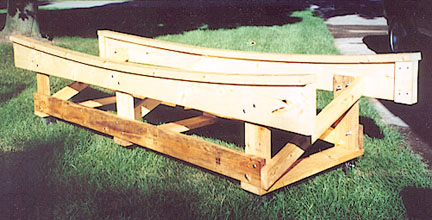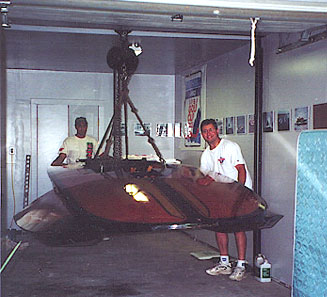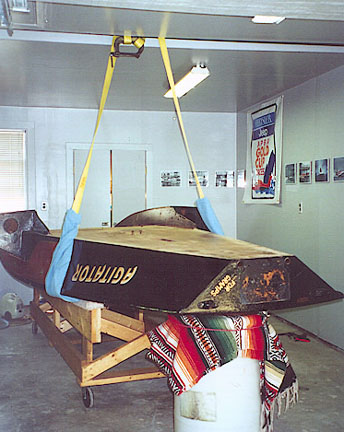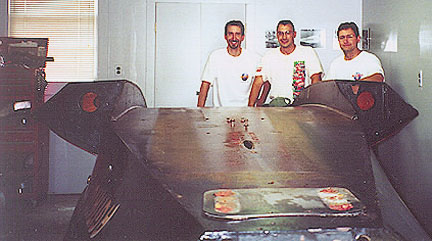WHAT?! Flipping your hydroplane!
Who in the world would want to read about this subject matter? I'm
sure every racer is immediately saying there are absolutely no benefits
to this occurrence and this is going to be one of the shortest articles
ever written. Now wait a minute! Hold on everyone. Calm down.
We are talking about flipping a hydroplane in your shop during the restoration
process, which usually if done right, does not involve almost drowning
or destroying your prized possession.
So why do I feel compelled to write a short article on this?
I’ll tell you why. There is seemingly a mystique or general cloudiness
surrounding this act, but nobody can argue, many people have done it in
the past. There are really no hard and fast rules. There are no specifications
for equipment. So what is one supposed to do when faced with this formidable
task?
Ask as many questions as you can.
Any time you run into a person lucky enough to own one of these incredible
machines - don’t let them go until they spill everything. The easiest way
to find such a person is by attending any inboard hydroplane event. They
are very easy to spot. They talk non-stop about hydroplanes in an
undeniable rhythm (I am also guilty of this). Many times they are sunburned,
missing meals and generally forgetting about all else except hydroplanes
when they are at one of these events. A person standing next to a vintage
hydroplane saying ‘I remember’ is always an excellent candidate.
Undoubtedly, at one point or another, this person has had a reason to turn
a hull over. Sometimes the conversation will lead to flipping a hydroplane
while racing. I have been told the directions for flipping while racing
are very simple. They are as follows:
Saying ‘I cant believe that guy is ahead of me’. or
Saying ‘I can't believe I'm in the lead’. Add in a few choice words after the aforementioned statements and your
boat is perfectly flipped. But that is not what we want to
know. That is what we never want to know. Remember, focus on
the ‘flipping in your shop’ part.
Review the many answers
That being said, after all my questioning of owners and trying to delve
into these deep dark secrets, I found some very similar comments that came
up on a regular basis as I thumbed through my notes.
Old tires were somehow involved.
The same friends that were ‘conned’ into flipping it upside-down
were all very mysteriously on vacation when the boat needed to be flipped
back over.
There was always one major injury…..however the injured person never
admitted to it.
The process usually involved 12 people with only 5 to 7 doing the
‘actual work’. I had multiple notes about a person maintaining
the correct pressure in the kegger - must be a pressure system for lifting
a boat or something like that?!
Everyone also agreed somebody should have had a video camera because
it was the craziest thing they ever volunteered to do.
Consequences
With this in mind I was about to tackle my project - flipping a 16’
long x 7’ wide, vintage 280-class racing hull.
So where do you begin when you realize you seemingly have to tackle
this daunting task? Complicating the fear factor on a vintage hull is the
fact you are probably dealing with a ‘one of a kind’. Now I'm sure back
when you were racing, if you damaged your own hull while flipping it, you
would be kicking yourself. Now if you damage the one of a kind,
kilo record holding, national point winning hull in original condition,
I'm sure some other people are going to be kicking you as well.
This fact in itself makes you think a lot more before saying ’Hey - lets
see if this will work’. I often found myself the last couple of weeks
waking up in the middle of the night thinking - ‘How much weight can a
sponson hold on edge before collapsing’? ‘How much weight could the
transom hold if I set the hull on it’? The answers are ‘I don’t know’ but
if I ever do find out the maximum load I know I’ll be very upset when I
hear the large snapping sound. The only guideline I have is to come up
with a method for your particular situation that works the first time without
any damage to your prized possession.
My Method
The following is what I did but it is by no means the only way to flip
a hydroplane. The only thing unique about the process I used was
the low number of people required for lifting (3) and nobody strained themselves
in the process. Why 3 people? That number is everyone who answered
my call of ‘Come over and help me lift a heavy boat’. Maybe next
time it will be ‘Come over for free beer and lunch' and after they
arrive, 'Oh by the way, lets flip my hydroplane over'. The way I
see it, if this article helps answer some questions for another owner,
a new comer or even just gives you a chuckle when you think back and remember
how you did it - mission accomplished!
The Task At Hand
Remove as much weight as you can.
The only thing that was still bolted to my hull at the time of flipping
was the structural aluminum cross bracing. Anything you can do to
eliminate weight is recommended but not compromising the structural integrity
of the hull is of the highest importance. Oh yeah. Take out the motor.
This helps a whole lot!
Build a rolling dolly.

I actually flipped my hydroplane in my garage with three people doing
the lifting and a forth playing the shuttle person for the rolling dolly(rolling
being the key word). Build any kind of dolly you want. Just make sure it
has capable casters and distributes the load over the structural members
of the hull. Here is a photo of the rolling dolly I came up with (I added
padding and carpet to the runners after this photo was taken).
The first thing we did was lift the boat off the trailer and get it
on the dolly right side up. I had previously put an ‘I’ beam in my garage
and we used that in conjunction with a hoist to lift the hull (A very low
cost system and works great for yanking the motor in and out as well. See
the photo of the hull hanging on my hoist just before we slid the rolling
dolly under it.)
 Once the hull
was on the dolly it was surprising how easily such a heavy object could
be pushed around with one hand. Once the hull
was on the dolly it was surprising how easily such a heavy object could
be pushed around with one hand.
Flipping methodology.
The theory we used was to put a heavy-duty tow strap (available at
any automotive store, and rated at 15,000 lbs.) around the top of the ‘I’
beam to create a cradle for the rear end of the hull. I chose to go close
to my cockpit where a structural frame was located. The width and
height of my hull at this location is 44” wide by 17” high. I also put
an old flannel bed sheet on the strap to minimize any scuffing where it
came in contact with the hull. The strap I bought was very soft and I ended
up with no scratches whatsoever across a varnished surface. I believe the
key is to make sure your varnish is dry and more importantly - hardened
(let it cure for at least three weeks). Once the strap was in place under
the hull we placed a heavy-duty plastic barrel under the rear end and shimmed
the hull high enough (3.5’ for my hull plus a little extra for the strap
stretch) so that if you flipped the hull on a horizontal axis the
front
sponsons would not hit the ground. To adjust the height of the sling I
simply added or subtracted wraps around the ‘I’ beam. Two large ‘C’ clamps
were placed through the sewn loops at the ends of the tow strap and we
were all set. Why two? Two is stronger than one, use three if you like!
However, I would recommend at least one wrap around your beam or whatever
so the strap actually cinches on itself and does not actually load the
‘C’ clamps.
 I suppose any
lifting point high enough and strong enough would do the job just fine
(I heard many stories involving a tree ‘Because the barn would have
collapsed if we'd tried it’). Once the rear end is at the proper height
supported by the cradle, the barrel can be removed and three lifters on
the front of the hull can easily (I say this now) pick the hull up and
the dolly can be immediately slipped out. At this point the strap is doing
a good portion of the holding. Once the dolly is slid out the same person
can slide a mattress (to prevent any scraping or cushion a disaster) directly
under the hull when it is being flipped. I saved an old queen mattress
I was going to throw out and it worked great. Now the lifters in
front can begin to turn the hull. As the hull rotates, it becomes too tall
for one of the three lifters to still be able to help so he or she proceeds
to the back of the hull. It is much easier to apply a torque to the rear
which greatly helps out the two remaining lifters in front. The whole process
takes only about 20 seconds. Move quickly but carefully. It was at this
point that I saw one of the craziest sites I’d ever seen. It is the equivalent
of taking something the same size as the car you are driving and turning
it over - pretty nutty. I think you 7 litre racers are something else.
Once the hull is finally upside-down, rapidly replace the dolly and breathe
a big sigh of relief. At this point, maybe this is where the special person
monitoring the pressure in the kegger comes in? I'm not sure. I suppose any
lifting point high enough and strong enough would do the job just fine
(I heard many stories involving a tree ‘Because the barn would have
collapsed if we'd tried it’). Once the rear end is at the proper height
supported by the cradle, the barrel can be removed and three lifters on
the front of the hull can easily (I say this now) pick the hull up and
the dolly can be immediately slipped out. At this point the strap is doing
a good portion of the holding. Once the dolly is slid out the same person
can slide a mattress (to prevent any scraping or cushion a disaster) directly
under the hull when it is being flipped. I saved an old queen mattress
I was going to throw out and it worked great. Now the lifters in
front can begin to turn the hull. As the hull rotates, it becomes too tall
for one of the three lifters to still be able to help so he or she proceeds
to the back of the hull. It is much easier to apply a torque to the rear
which greatly helps out the two remaining lifters in front. The whole process
takes only about 20 seconds. Move quickly but carefully. It was at this
point that I saw one of the craziest sites I’d ever seen. It is the equivalent
of taking something the same size as the car you are driving and turning
it over - pretty nutty. I think you 7 litre racers are something else.
Once the hull is finally upside-down, rapidly replace the dolly and breathe
a big sigh of relief. At this point, maybe this is where the special person
monitoring the pressure in the kegger comes in? I'm not sure.
This photo depicts the strap set up and the barrel we used.
Conclusion
All of these people were key to doing the job safe and getting it done
right. The photo of the 3-man lifting team was taken by Lisa Cook, my very
understanding girlfriend/chief dolly and trailer puller. Left to right
- Tired Agitator pilot, my good friends Wally Hinman and Frank Pozar.
I will guarantee you  this…..if
you have ever flipped one over, this…..if
you have ever flipped one over,
you will never forget it. So what are the benefits of flipping a hydroplane you ask? Friendship,
an excellent demonstration of teamwork, being faced with a problem and
solving it (a great feeling for any engineer), realizing you are almost
complete with your restoration, being able to finally inspect what is really
between you and the water…..and oh yeah…..a much easier way to varnish
the bottom of your hull without it dripping down on your head.
Have A Safe Flipping!
©2001 Alan Radue
Back to the Technical
Articles
|